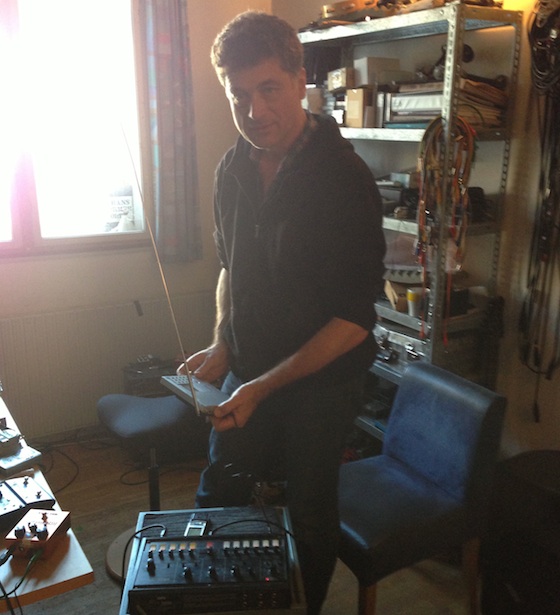Digital Materialism “From A Medium To Material” тАУ уГбуГЗуВгуВвуБЛуВЙуГЮуГЖуГкуВвуГлуБ╕уААтАЬуГЗуГ╝уВ┐уГЮуГЖуГкуВвуГкуВ║уГатАЭ (essay)

уГбуГЗуВгуВвуБЛуВЙуГЮуГЖуГкуВвуГлуБ╕уААтАЬуГЗуГ╝уВ┐уГЮуГЖуГкуВвуГкуВ║уГатАЭ тАУ┬аEssay by Yousuke Fuyama.
Originally printed in ZINE #6 “Locating Electronic Music”. Please find English version below.
уГЗуГ╝уВ┐уБпуБЭуВМуВТхПЦуВКх╖╗уБПуГЖуВпуГОуГнуВ╕уГ╝уБохК╣чОЗхМЦуБищлШщАЯхМЦуБоцЮЬуБжуБлуАБуГбуГЗуВгуВвуБиуБЧуБжуБоф╝ЭщБФуБоуБЯуВБуБох╜вцЕЛуБицйЯшГ╜уБихРМчнЙуБЛуБЭуВМф╗еф╕КуБлуАБуГЮуГЖуГкуВвуГлуБиуБЧуБжуАБуБЭуВМуБЭуБоуВВуБоуБиуБЧуБжуБоуГкуВвуГкуГЖуВгуВТцМБуБдуБУуБиуБлуБкуБгуБЯуАВуБЭуВМуБлуВИуБгуБжуГЗуГ╝уВ┐хМЦуБХуВМуБЯуВ│уГ│уГЖуГ│уГДуБМуВ╣уГИуГкуГ╝уГаф╕КуБзшнШхИеуГ╗хЗжчРЖуГ╗ф║дцПЫуБХуВМуВЛуБЯуВБуБоцзШуАЕуБкхЕеуВМчЙйуБиуБЧуБжуБоуГбуВ┐уГЗуГ╝уВ┐уАБуГЗуГ╝уВ┐х╜вх╝ПуАБуГПуГ╝уГЙуВжуВзуВвуБиуБДуБгуБЯуГбуГЗуВгуВвчЙ╣цАзуБЭуБоуВВуБоуБохнШхЬиуБМуВ│уГ│уГЖуГ│уГДуБЭуВМшЗкф╜УуВТц▒║хоЪуБЧх╛ЧуВЛх╝╖хКЫуБкх╜▒щЯ┐хКЫуВТцМБуБбхзЛуВБуВЛуБУуБиуБлуБкуБгуБЯуАВуВ│уГ│уГЖуГ│уГДуВТф╕╗ф╜УуБиуБЧуБжуБЭуВМуБлщБйуБЧуБЯх╜вх╝ПуВТщБ╕уБ╢уБоуБзуБпуБкуБПуАБх╜вх╝ПуБЭуБоуВВуБоуБМщАЖшкмчЪДуБлуВ│уГ│уГЖуГ│уГДуВТшжПхоЪуБЧуАБхдЙхо╣уБХуБЫуВЛуАВтАЭцДПхС│уБоф╣ЧуВКчЙй(vehicle)тАЭуБзуБВуБгуБЯуГЗуГ╝уВ┐уБМтАЭшЗкх╛ЛчЪДуБкуГХуГйуВдуГ│уВ░уВкуГЦуВ╕уВзуВпуГИтАЭуБ╕уБихдЙш▓МуБЧуБЯуБоуБзуБВуВЛуАВуГКуГауВ╕уГеуГ│уГСуВдуВпуБиуГЦуГйуВжуГ│чобуАБуВ╕уГзуГ│уВ▒уГ╝уВ╕уБиуГйуВ╕уВкуАБуГФуВиуГ╝уГлуВ╖уВзуГХуВзуГ╝уГлуБичгБц░ЧуГЖуГ╝уГЧуБощЦвф┐ВцАзуБлшжЛуВЙуВМуВЛуГбуГЗуВгуВвуБихЙ╡щАацАзуБлуБКуБСуВЛуГЖуВпуГОуГнуВ╕уВлуГлуБкуГСуГйуГАуВдуГауВ╖уГХуГИуБихРМцзШуБочП╛ш▒буВТшжЛуБжхПЦуВЛуБУуБиуБМуБзуБНуВЛуАВ
уБХуВЙуБлуГЗуГ╝уВ┐уБощЫЖхРИуБпуАБуГЗуВ╕уВ┐уГлуБиуБДуБЖх╜вх╝ПуБлуБКуБДуБжуБйуБоуВИуБЖуБкшбих▒дуВТх╜вцИРуБЧуБжуБДуБЯуБиуБЧуБжуВВуАБуБЩуБ╣уБжуВТуГРуВдуГКуГкцГЕха▒уБиуБЧуБжщВДхЕГхПпшГ╜уБкуБЯуВБуАБхОЯчРЖчЪДуБлуБпц╕мхоЪхПпшГ╜уБкчЙйчРЖф╕ЦчХМуБЛуВЙцК╜хЗ║уБЧуБЯуБВуВЙуВЖуВЛуГЗуГ╝уВ┐уВТхРМф╕АуБоуГРуВдуГКуГкцмбхЕГф╕КуБзф╕АцЛмуБлцЙ▒уБЖуБУуБиуБМхПпшГ╜уБзуБВуВЛуАВуБЭуБУуБзуБпцЬмцЭеуВ│уГ│уГЖуГ│уГДуВТшжПхоЪуБЩуВЛуБЯуВБуБоуГбуВ┐уГЗуГ╝уВ┐уВДшиШщМ▓х╜вх╝ПуБЭуБоуВВуБоуВВуАБуВ│уГ│уГЖуГ│уГДуБихРМцмбхЕГуБочФ╗ф╕АчЪДуБкуГРуВдуГКуГкуБощЫЖхРИуБиуБЧуБжщВДхЕГуБХуВМуВЛуАВ
уБДуВПуБ░ц╡БхЛХчЪДуБзф╕Нчв║хоЪуБкхОЯхнРчЪДуГЗуГ╝уВ┐ч╛дуБМуАБуВ╖уГкуВ│уГ│ф╕КуБзхОЯхнРшлЦчЪДуБкф╗оцГ│чй║щЦУуВТх╜вцИРуБЧуБжуБДуВЛуБоуБзуБВуВЛуАВуБ╛уБЯуБЭуВМуБпуВ│уГ╝уГЙуБиуБДуБЖщЗНхКЫуБлуВИуБгуБжф║ТуБДуБлч╡РхРИуБЧуАБчХ░уБкуБгуБЯхоЯф╜УуБиуБЧуБжхЖНцзЛчпЙуБХуВМчЙйчРЖф╕ЦчХМуБ╕уБишИЮуБДцИ╗уВЛуАВ
уБУуБЖуБЧуБЯчК╢ц│БуБпуАБхоЯф╜УуБоцГЕха▒уВТц╕мхоЪуГ╗шиШщМ▓уГ╗ф╝ЭщБФуБЩуВЛуБЯуВБх╜вх╝ПуБзуБВуБгуБЯуГЗуВ╕уВ┐уГлуБМуАБуБЭуБоц▒ОчФицАзуБицЩощБНцАзуБлуВИуБгуБжуБВуВЙуВЖуВЛхоЯф╜УуБЛуВЙуБоуГЗуГ╝уВ┐уВТхР╕хПОуГ╗шЮНхРИуГ╗хдЙцПЫуБЩуВЛуБУуБиуВТхПпшГ╜уБиуБЧуБЯуБУуБиуБзуАБчХ░уБкуБгуБЯуГЗуВ╕уВ┐уГлуГбуГЗуВгуВвуВТшбМуБНцЭеуБЩуВЛуБЯуВБуБоуВиуГ│уВ│уГ╝уГЙуВДуГЗуВ│уГ╝уГЙуБиуБДуБЖуГЗуВ╕уВ┐уГлуБочЙ╣цАзчЪДуБкуГЧуГнуВ╗уВ╣уБЭуБоуВВуБоуБМхЙ╡щАацЙЛц│ХуБиуБЧуБжуБохПпшГ╜цАзуВТщЦЛуБПуБУуБиуБлуБкуБгуБЯуБУуБиуВТчд║уБЩуАВ
ф╗КуВДуГЧуГнуВ░уГйуГЯуГ│уВ░шиАшкЮуГ╗уГбуВ┐уГЗуГ╝уВ┐уГ╗ц╝ФчоЧуГ╗уГХуВгуГ╝уГЙуГРуГГуВпуГ╗уВ╡уГ│уГЧуГкуГ│уВ░уГмуГ╝уГИуГ╗шиШцЖ╢хо╣щЗПуГ╗уГЗуВгуВ╣уВпуГ╗уГПуГ╝уГЙуВжуВзуВвуБиуБДуБгуБЯуБВуВЙуВЖуВЛуГЗуГ╝уВ┐уБоф╝ЭщБФуГЧуГнуВ╗уВ╣уБЭуБоуВВуБоуБМхЙ╡щАауБлуБКуБСуВЛц▒║хоЪчЪДуБкшбичП╛цЙЛцо╡уБоуБ▓уБиуБдуБиуБкуБгуБЯуАВ
уБЭуВМуБпхРМцЩВуБлуАБхН░хИ╖цКАшбУуБЛуВЙч╢ЪуБПуВкуГкуВ╕уГКуГлуБиуВ│уГФуГ╝уБохвЧцоЦуБлуВИуВЛуВвуВжуГйуБохЦкхд▒уБМуАБуГЗуВ╕уВ┐уГлхдЙцПЫуГЧуГнуВ╗уВ╣ф╕КуБзф╕НхПпщБ┐уБлчЩ║чФЯуБЩуВЛуГЗуВ╕уВ┐уГлуВиуГйуГ╝уВДуВ░уГкуГГуГБуБлуВИуБгуБжхЖНх║жчН▓х╛ЧуБХуВМуАБуБЭуВМуБМуГНуВмуГЖуВгуГ┤уБкуГОуВдуВ║уБиуБЧуБжуБохЙпчФгчЙйуБЛуВЙуАБуГАуВдуГКуГЯуГГуВпуБзхЛХчЪДуБзф║Иц╕мф╕НхПпшГ╜уБЛуБдхдЪцзШуБкуВвуВжуГйуВТхНКуВкуГ╝уГИуГЮуГЖуВгуВпуБлчФЯцИРуБЧч╢ЪуБСуВЛхПпшГ╜цАзуБЭуБоуВВуБоуБ╕уБихдЙхМЦуБХуБЫуВЛуБУуБиуБлуВВуБкуБгуБЯуАВуБДуБ╛уВДуГЗуВ╕уВ┐уГлуВ│уГФуГ╝уБпхНШч┤ФуБкшдЗшг╜уБзуБпуБкуБПуАБуБ▓уБиуБдуБохЙ╡щАацЙЛцо╡уБкуБоуБзуБВуВКуАБуГЗуГ╝уВ┐уГЮуГЖуГкуВвуГлуВТхдЙхо╣уБХуБЫуВЛцДПцАЭф╗ЛхЕеуБохеСцйЯуБицИРуВКуБЖуВЛуАВ
уБУуБЖуБЧуБЯчК╢ц│БуБпуГЗуГ╝уВ┐уВТцЙ▒уБЖхЙ╡щАацЙЛцо╡уВТхдЪцзШхМЦуБХуБЫуАБуВ│уГФуГ╝уВДуГИуГмуГ╝уВ╣уВТш╢ЕуБИуБЯуВвуВжуГйуВТх╕пуБ│уБЯуВ░уГкуГГуГБуВДуВиуГйуГ╝уАБуВкуГ╝уГИуГЮуГИуГ│уВДуГХуВгуГ╝уГЙуГРуГГуВпуАБуВ│уГ╝уГЗуВгуГ│уВ░уВДуВдуГ│уВ┐уГйуВпуВ╖уГзуГ│уВТчФЯуБ┐хЗ║уБЧуАБуГЗуВ╕уВ┐уГлуВТчФиуБДуБЯхЙ╡щАауБлцЦ░уБЯуБкуГЖуВпуГОуГнуВ╕уВлуГлуБкцмбхЕГуВТщЦЛцЛУуБЧуБЯуБМуАБуБХуВЙуБлуБЭуВМуБпуБЩуБ╣уБжуБМуГЗуГ╝уВ┐уБлщВДхЕГуБХуВМуВЛтАЭуБиуБДуБЖф║ЛхоЯуБлуВИуБгуБжуАБуГЗуГ╝уВ┐уБощЫЖхРИуБЛуВЙцзЛчпЙуБХуВМуВЛф╗оцГ│ф╕ЦчХМуВТщАЪуБШуБЯчЙйчРЖф╕ЦчХМуБ╕уБоцЦ░уБЯуБкшжЦх║зуВТуГХуВгуГ╝уГЙуГРуГГуВпуБЧуБжуБДуВЛуАВ
уБЭуВМуБпхФпчЙйшлЦчЪД(уГЮуГЖуГкуВвуГкуВ║уГЯуГГуВп)уБкуГЛуГТуГкуВ║уГауБзуБВуВКуАБуГЗуГ╝уВ┐уБлуВИуБгуБжчй╢це╡чЪДуБлхоЗхоЩхЕиуБжуБМшиИчоЧхПпшГ╜уБкуГРуВдуГКуГкуБоч╛ЕхИЧуБицНЙуБИуВЛуБУуБиуБзуАБуГЗуВ╕уВ┐уГлуВТхПЦуВКх╖╗уБПчТ░хвГхЕиуБжуБлцЩощБНчЪДуГ╗ц╜ЬхЬичЪДуБлхнШхЬиуБЩуВЛцДЯшжЪуБауАВчП╛хоЯф╕ЦчХМуБЛуВЙуБйуБоуВИуБЖуБкхп╛ш▒буВТуГЗуГ╝уВ┐хМЦуБЧуБЯуБиуБЧуБжуВВуАБуВ│уГ│уГЖуГ│уГДуБиуБЧуБжцДЯцГЕуВДф╕╗шж│уВТхЦЪш╡╖уБЩуВЛуГкуВвуГкуВ║уГауБМчДбхК╣хМЦуБХуВМуАБуВ╖уГкуВ│уГ│уВТц╝ВуБЖч▓ТхнРуБощЫЖхРИуБиуБЧуБжхнШхЬиуБЧх╛ЧуВЛф║ЛхоЯуБпцн┤чД╢уБицикуБЯуВПуБгуБжуБДуВЛуБоуБауАВ
хПдуБПуБЛуВЙуБоф╗ПцХЩуБоцХЩуБИуБлуБпуАМшЙ▓хН│цШпчй║(shiki-soku-ze-kuu)уАНуБиуБДуБЖцжВх┐╡уБМуБВуВЛуАВшЙ▓уБпхоЯф╜УуВТцМБуБдхнШхЬиуАБчй║уБпхоЯф╜УуБоуБкуБДхнШхЬиуВТуБЭуВМуБЮуВМцМЗуБЧуБжуБКуВКуАБуБЭуВМуВЙуБМуВдуВ│уГ╝уГлуБзч╡РуБ░уВМуБжуБДуВЛуАВхоЯф╜УуВДчП╛ш▒буБпуБЭуВМшЗкф╜УуБзуБпхнШхЬиуБЫуБЪуАБф║ТуБДуБлщЦвщАгуБЧуБВуБЖуБУуБиуБзф╕ЦчХМуБМцИРуВКчлЛуБбуАБуБЭуБощАЖуВВуБ╛уБЯчЬЯуБкуВКуБишкмуБПуАВ
уГЗуВ╕уВ┐уГлуГЗуГ╝уВ┐уБЭуВМшЗкф╜УуБпщЫ╗ц░Чф┐бхП╖уБиуБЧуБжуБохоЯф╜УуБМхнШхЬиуБЧуБжуБДуБжуВВуАБф║║щЦУуБлуБиуБгуБжшкНшнШхПпшГ╜уБкуБВуВЛх╜вх╝ПуБиуБЧуБжф║ТуБДуБлщЦвщАгуБеуБСуВЙуВМуБкуБСуВМуБ░уАБуБЭуВМуВЙуБМшкНшнШуБХуВМхоЯф╜УхМЦуБЩуВЛуБУуБиуБпуБкуБДуАВуБЭуБоцДПхС│уБзуВ│уГ│уГФуГеуГ╝уВ┐уБлуВИуВЛуГЗуГ╝уВ┐уБоцМпуВЛшИЮуБДуБиуБпуАБуАМшЙ▓(siki)уАНуБиуАМчй║(kuu)уАНуБочК╢цЕЛуБочЫ╕ф║ТхдЙцПЫшгЕч╜оуБицНЙуБИуВЛуБУуБиуБМуБзуБНуВЛуБауВНуБЖуАВуГЗуВ╕уВ┐уГлуГЮуГЖуГкуВвуГкуВ║уГауБиуБпхоЗхоЩуВТуАМчй║шж│(kuu-ganуАБуБЩуБ╣уБжуВТчй║уБощЫЖхРИуБиуБЧуБжф╕ЦчХМуВТцНЙуБИуВЛшжЛцЦ╣)уАНуБЩуВЛцЕЛх║жуБзуБВуВЛуАВуБдуБ╛уВКуГЗуГ╝уВ┐уБиуБЧуБжц╕мхоЪуБХуВМцК╜ш▒бхМЦуБХуВМуБЯчП╛хоЯф╕ЦчХМуБохоЯф╜У(шЙ▓)уБпуАБуБЩуБзуБлхоЯф╜УуВТхд▒уБгуБЯуГЗуГ╝уВ┐(чй║)уБочК╢цЕЛуБиуБЧуБжф╗оцГ│ф╕ЦчХМуБлф┐ЭхнШуБицЫ╕уБНцПЫуБИуБМшбМуВПуВМуАБуБЭуВМуВЙуБлхп╛уБЧуБжхЖНх║жшкНшнШхПпшГ╜уБкх╜вх╝ПуВТф╕ОуБИуВЛуБУуБиуБзхоЯф╜У(шЙ▓)уБочК╢цЕЛуБ╕хдЙцПЫуБХуВМуВЛуБоуБзуБВуВЛуАВчй║уБзуБВуВЛуБкуВЙуБ░уБЭуБУуБлцДЯцГЕуВВцДПхС│уВВхнШхЬиуБЧуБкуБДуАВ
уБЧуБЛуБЧуБЭуБУуБлуБпуАБф╜ХуВВуБкуБДуАБуБиуБДуБЖф║ЛхоЯуБпчв║хоЯуБлхнШхЬиуБЩуВЛуАВщЭЮхнШхЬиуБиуБЧуБжуБохнШхЬиуБоуГкуВвуГкуГЖуВгуБМуАБуГЗуГ╝уВ┐уВ╣уГИуГкуГ╝уГауБЭуБоуВВуБоуВТчЯешжЪуБЩуВЛуБУуБиуБлуВИуБгуБжчлЛуБбчП╛уВМуБжуБПуВЛуБоуБауАВ

Digital Materialism тАУ From A Medium To Material┬а
Data has gained a reality. Technological advancement transformed data from a mere communication medium into something with a reality. Data materials now exercise a very powerful influence over the contents which they represent. The former can define and alter the latter. Once data was a vehicle of meaning while now it is an independent flying object. Arguably, this phenomenon can be viewed as a technological paradigm shift in the relationship between media and creativity, similar to what presented by Nam Jun Paik with TV, John Cage with radio, and Pierre Schaeffer with magnetic tapes.
Essentially, any set of data including metadata and recording formats can be resolved into binary information regardless of what shape they take. When considering all data belong to the physical world which can in principle be measurable, they should be treated on the same binary plane. Namely, collections of fluid and indefinite atomic data form a virtual space on the silicon level. They are bound together by the gravity called codes, then reconstructed as a different substance and returned to the physical world.
Because digitality is generic and universal by nature, virtually anything today can be absorbed, merged, and converted as data. On that account, the movement of those data, that is, digital transmission process itself can be one of the definite modes of artistic expression.
Aura is said to have been lost through the repetition of copying since the invention of printing. Yet it can be re-gained thanks to errors and glitches inevitably arising from the digital conversion process. Such by-products are not negative noise. In fact, they should be recognized as possibilities to re-create aura that are both dynamic and unpredictable. Digital copying thus is not a simple replication, but can be a positive and creative opportunity to transform the subject dealt with. Other digital process and modes such as encoding and decoding, programming languages, metadata, operation, feedback, sampling rate, memory capacity, discs, hardware, automata, and interactions can also function in such a way.
Here, it is relevant to bring the views of materialistic nihilism and Buddhism. According to materialistic nihilism, everything can be measurable by data and therefore all that in the universe are enumerations of binary data. Any realism suggesting emotion and subjectivity no longer exists once it is made into data and becomes a mere collection of particles floating in the silicon space.
Buddhism teaches the idea of Shiki-Soku-Ze-Kuu. That is, color equals emptiness and vice versa. Color represents existence or entity while emptiness means void. Namely, no substance exists by itself and the world is therefore all made up of the sheer relationships of the contrasting two.
In a similar perspective, digital materialism views the universe as an aggregation of emptiness. Digital data exist as electric signals. Nonetheless, they are void and cannot be recognized unless they are given a form that relates themselves to each other. When a reality is measured, abstracted and saved in the virtual world as data, it loses its entity. It is only made present again when given a recognizable form.
While in data hence void, there should not be an emotion nor a meaning.
Yet one thing does exist. That is an absoluteness that all is void. In the midst of data streams, we feel this ultimate entity as nonentity.
Info:Yousuke Fuyama was born in Nagano, Japan in 1983. He is an artist, composer, programmer, visual and graphic designer. Yousuke Fuyama┬аis the featured artist of Passive/Aggressive ZINE #6, which is out now in Copenhagen, Tokyo, New York and Berlin. Read more:┬аhttp://passiveaggressive.dk/passiveaggressive-new-magazine-gets-international-release/


